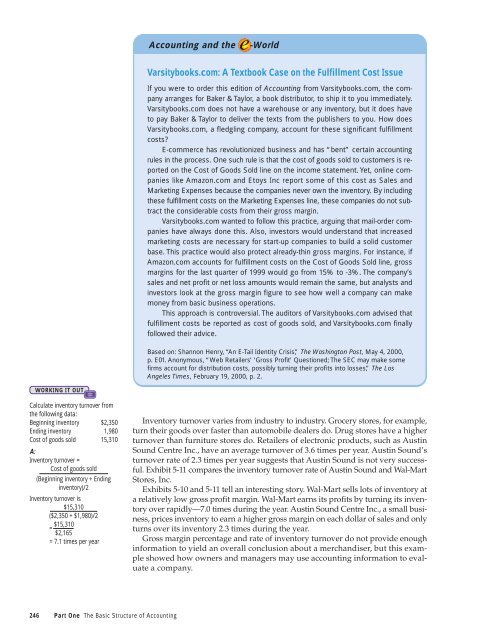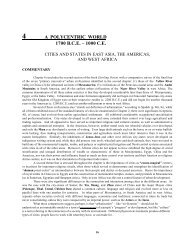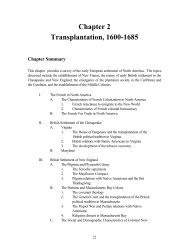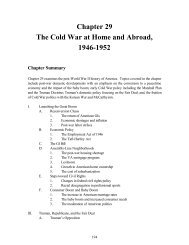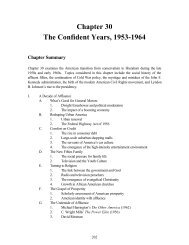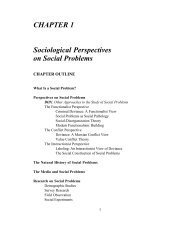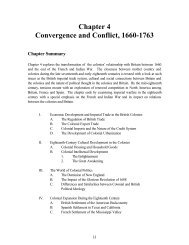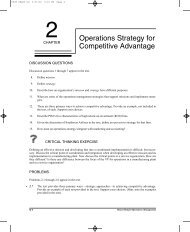Merchandising Operations and the Accounting Cycle - Pearson
Merchandising Operations and the Accounting Cycle - Pearson
Merchandising Operations and the Accounting Cycle - Pearson
You also want an ePaper? Increase the reach of your titles
YUMPU automatically turns print PDFs into web optimized ePapers that Google loves.
WORKING IT OUT<br />
Calculate inventory turnover from<br />
<strong>the</strong> following data:<br />
Beginning inventory $2,350<br />
Ending inventory 1,980<br />
Cost of goods sold 15,310<br />
A:<br />
Inventory turnover =<br />
Cost of goods sold<br />
(Beginning inventory + Ending<br />
inventory)/2<br />
Inventory turnover is<br />
$15,310<br />
($2,350 + $1,980)/2<br />
= $15,310<br />
$2,165<br />
= 7.1 times per year<br />
246 Part One The Basic Structure of <strong>Accounting</strong><br />
<strong>Accounting</strong> <strong>and</strong> <strong>the</strong> -World<br />
Varsitybooks.com: A Textbook Case on <strong>the</strong> Fulfillment Cost Issue<br />
If you were to order this edition of <strong>Accounting</strong> from Varsitybooks.com, <strong>the</strong> company<br />
arranges for Baker & Taylor, a book distributor, to ship it to you immediately.<br />
Varsitybooks.com does not have a warehouse or any inventory, but it does have<br />
to pay Baker & Taylor to deliver <strong>the</strong> texts from <strong>the</strong> publishers to you. How does<br />
Varsitybooks.com, a fledgling company, account for <strong>the</strong>se significant fulfillment<br />
costs?<br />
E-commerce has revolutionized business <strong>and</strong> has “bent” certain accounting<br />
rules in <strong>the</strong> process. One such rule is that <strong>the</strong> cost of goods sold to customers is reported<br />
on <strong>the</strong> Cost of Goods Sold line on <strong>the</strong> income statement. Yet, online companies<br />
like Amazon.com <strong>and</strong> Etoys Inc report some of this cost as Sales <strong>and</strong><br />
Marketing Expenses because <strong>the</strong> companies never own <strong>the</strong> inventory. By including<br />
<strong>the</strong>se fulfillment costs on <strong>the</strong> Marketing Expenses line, <strong>the</strong>se companies do not subtract<br />
<strong>the</strong> considerable costs from <strong>the</strong>ir gross margin.<br />
Varsitybooks.com wanted to follow this practice, arguing that mail-order companies<br />
have always done this. Also, investors would underst<strong>and</strong> that increased<br />
marketing costs are necessary for start-up companies to build a solid customer<br />
base. This practice would also protect already-thin gross margins. For instance, if<br />
Amazon.com accounts for fulfillment costs on <strong>the</strong> Cost of Goods Sold line, gross<br />
margins for <strong>the</strong> last quarter of 1999 would go from 15% to -3%. The company’s<br />
sales <strong>and</strong> net profit or net loss amounts would remain <strong>the</strong> same, but analysts <strong>and</strong><br />
investors look at <strong>the</strong> gross margin figure to see how well a company can make<br />
money from basic business operations.<br />
This approach is controversial. The auditors of Varsitybooks.com advised that<br />
fulfillment costs be reported as cost of goods sold, <strong>and</strong> Varsitybooks.com finally<br />
followed <strong>the</strong>ir advice.<br />
Based on: Shannon Henry, “An E-Tail Identity Crisis,” The Washington Post, May 4, 2000,<br />
p. E01. Anonymous, “Web Retailers’ ‘Gross Profit’ Questioned; The SEC may make some<br />
firms account for distribution costs, possibly turning <strong>the</strong>ir profits into losses,” The Los<br />
Angeles Times, February 19, 2000, p. 2.<br />
Inventory turnover varies from industry to industry. Grocery stores, for example,<br />
turn <strong>the</strong>ir goods over faster than automobile dealers do. Drug stores have a higher<br />
turnover than furniture stores do. Retailers of electronic products, such as Austin<br />
Sound Centre Inc., have an average turnover of 3.6 times per year. Austin Sound’s<br />
turnover rate of 2.3 times per year suggests that Austin Sound is not very successful.<br />
Exhibit 5-11 compares <strong>the</strong> inventory turnover rate of Austin Sound <strong>and</strong> Wal-Mart<br />
Stores, Inc.<br />
Exhibits 5-10 <strong>and</strong> 5-11 tell an interesting story. Wal-Mart sells lots of inventory at<br />
a relatively low gross profit margin. Wal-Mart earns its profits by turning its inventory<br />
over rapidly—7.0 times during <strong>the</strong> year. Austin Sound Centre Inc., a small business,<br />
prices inventory to earn a higher gross margin on each dollar of sales <strong>and</strong> only<br />
turns over its inventory 2.3 times during <strong>the</strong> year.<br />
Gross margin percentage <strong>and</strong> rate of inventory turnover do not provide enough<br />
information to yield an overall conclusion about a merch<strong>and</strong>iser, but this example<br />
showed how owners <strong>and</strong> managers may use accounting information to evaluate<br />
a company.


